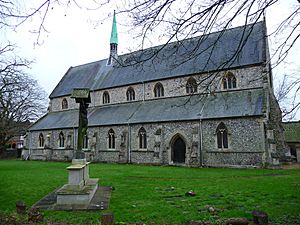Holy Trinity Church, Winchester facts for kids
Quick facts for kids Holy Trinity Church, Winchester |
|
|---|---|
 |
|
| OS grid reference | SU 48357 29722 |
| Country | England |
| Denomination | Church of England |
| Churchmanship | Anglo-Catholic |
| Architecture | |
| Architect(s) | Henry Woodyer |
| Style | "Early Decorated" |
| Years built | 1853-55 |
| Construction cost | £4,780 |
| Administration | |
| Deanery | Winchester |
| Diocese | Winchester |
Holy Trinity Church, Winchester is a Church of England parish church. It is located in Winchester, a city in Hampshire, England.
History of the Church
Holy Trinity Church is a special type of church called a Commissioners' church. These churches were built using money approved by the British Parliament. This happened because of laws passed in 1818 and 1824, known as the Church Building Acts.
The church received £300 from the Second Parliamentary Grant. This money helped to build Holy Trinity Church. It was a significant amount back then.
On January 14, 1974, the church was given a special status. It was named a grade II* listed building. This means it is a very important historical building.
The Church Today
Holy Trinity Church follows the Catholic tradition within the Church of England. This means it has some practices similar to the Roman Catholic Church.
The church has made decisions about its beliefs. For example, it does not support the ordination of women as priests. It is also part of groups like Forward in Faith and The Society.
The church receives guidance from a special bishop. This is called alternative episcopal oversight. Currently, the Bishop of Richborough, Norman Banks, provides this guidance.
External Links
- Official Website of Holy Trinity Church, Winchester: http://www.holytrinitywinchester.co.uk

